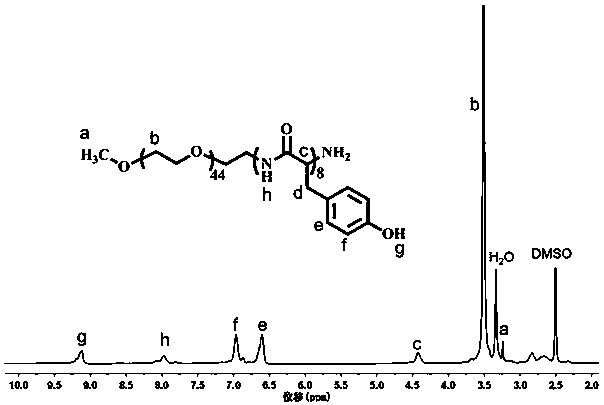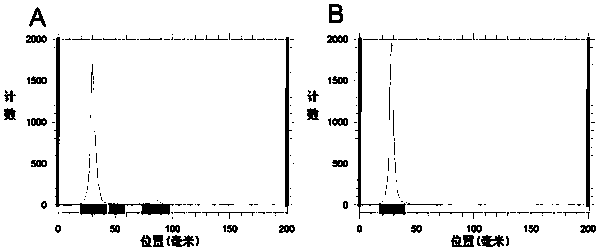Injectable polypeptide hydrogel for local tumor radiotherapy and preparation method thereof
A hydrogel and topical technology, applied in the field of injectable polypeptide hydrogel and its preparation, can solve the pain of tumor treatment and postoperative healing of patients, the troubles and troubles of radiotherapy plan formulation and implementation, and achieve good cell growth inhibition effect, good degradability, and highly specific tumor-killing effect
- Summary
- Abstract
- Description
- Claims
- Application Information
AI Technical Summary
Problems solved by technology
Method used
Image
Examples
Embodiment 1
[0030] Example 1: mPEG-p(Tyr) 4 Preparation and Characterization of Copolymers
[0031] Polyethylene glycol (mPEG-NH) with a molecular weight of 2000 g / moL and methoxyl and amino 2 , 2.0 g) and tyrosine-N-carboxy-cyclic anhydride (Tyr-NCA, 0.873 g) were dissolved in 5 mL of anhydrous dimethylformamide, and reacted in a water bath at 30 °C for 48 hours. Then, the reaction solution was added dropwise to glacial ether, filtered, the precipitate was taken, and vacuum-dried to obtain the copolymer mPEG-p(Tyr) of polyethylene glycol and polytyrosine. x , by H NMR spectroscopy 1 The degree of polymerization of the tyrosine monomer in the product identified by H NMR analysis was 4. The polymerization reaction equation and the chemical structure of the product are as follows figure 1 shown.
Embodiment 2
[0032] Example 2: mPEG-p(Tyr) 8 Preparation and Characterization of Copolymers
[0033] Polyethylene glycol (mPEG-NH) with a molecular weight of 2000 g / moL and methoxyl and amino 2 , 1.0 g) and tyrosine-N-carboxy-cyclic anhydride (Tyr-NCA, 0.873 g) were dissolved in 5 mL of anhydrous dimethylformamide, and reacted in a water bath at 30 °C for 48 hours. Then, the reaction solution was added dropwise to glacial ether, filtered, the precipitate was taken, and vacuum-dried to obtain the copolymer mPEG-p(Tyr) of polyethylene glycol and polytyrosine. x, by H NMR spectroscopy 1 The degree of polymerization of the tyrosine unit in the H NMR analysis product is 8, the result is as follows figure 2 As shown, the polymer is labeled as mPEG-p(Tyr) 8 .
Embodiment 3
[0034] Example 3: mPEG-p(Tyr) 10 Preparation and Characterization of Copolymers
[0035] Polyethylene glycol (mPEG-NH) with a molecular weight of 2000 g / moL and methoxyl and amino 2 , 1.0 g) and tyrosine-N-carboxy-cyclic anhydride (Tyr-NCA, 1.09 g) were dissolved in 20 mL of anhydrous dimethylformamide, and reacted in a water bath at 30 °C for 48 hours. Then, the reaction solution was added dropwise to glacial ether, filtered, the precipitate was taken, and vacuum-dried to obtain the copolymer mPEG-p(Tyr) of polyethylene glycol and polytyrosine. x , by H NMR spectroscopy 1 H NMR analysis showed that the degree of polymerization of tyrosine units in the product was 10.
PUM
| Property | Measurement | Unit |
|---|---|---|
| concentration | aaaaa | aaaaa |
| degree of polymerization | aaaaa | aaaaa |
Abstract
Description
Claims
Application Information
 Login to View More
Login to View More - R&D
- Intellectual Property
- Life Sciences
- Materials
- Tech Scout
- Unparalleled Data Quality
- Higher Quality Content
- 60% Fewer Hallucinations
Browse by: Latest US Patents, China's latest patents, Technical Efficacy Thesaurus, Application Domain, Technology Topic, Popular Technical Reports.
© 2025 PatSnap. All rights reserved.Legal|Privacy policy|Modern Slavery Act Transparency Statement|Sitemap|About US| Contact US: help@patsnap.com



